
Report Highlight: Workforce Diversity
Representation Matters
Seattle Children’s aims to have a workforce that reflects the diversity of patients and families served. Research shows this improves health outcomes, patient and family experience, and innovation. Diverse representation across all levels of the organization is important as every role — not only clinical providers- contributes to the whole Seattle Children’s culture and atmosphere and how patients and families experience Seattle Children’s.
Diversifying the Workforce and Addressing Challenges
Currently meeting the goal of 40% employee racial and ethnic diversity, Seattle Children’s numbers are moving the right direction. Over the past five years, Seattle Children’s has seen the following progress:
- The Executive Leadership Team increased from 0% racial and ethnic diversity in 2017 to 45.5% in 2022.
- Managers across the organization increased from 17.3% racial and ethnic diversity in 2017 to 25.1% in 2022.
- Nursing — one of the largest employee groups — increased from 19.2% racial and ethnic diversity in 2017 to 25.3% in 2022.
Racial and ethnic diversity has continued to increase in both the patient and employee population; employee racial and ethnic diversity is outpacing patient diversity (an increase of 3.8% compared to 2.4%). Currently, there is concordance between patients and employees who are Black/African American (both represent 6.6–6.7% of their respective populations) and Native Hawaiian and other Pacific Islanders (0.8% of their respective populations).
However, the Hispanic/Latinx population remains the area where Seattle Children’s has the biggest opportunity relative to its patient population with patients representing 19.1% and employees representing 7.7% of their respective populations.
The current labor market is extremely competitive, and Seattle Children’s is not immune to employee retention challenges as people reevaluate where and how they want to work. The organization must stay focused on creating an inclusive work environment and retaining its talented workforce. Seattle Children’s has developed a number of programs and opportunities in support of the workforce, including:
- Investing in Inclusion Network (IN) member professional development and leadership from compensating IN leaders to financially sponsoring members to participate in leadership programs such as Ceresa and the Women of Color Leadership Program.
- Investing in leader development pilot programs for frontline leaders, coaching and mentoring for high-impact leaders and an executive development program to support succession planning. These programs will be evaluated and scaled accordingly.
- Increasing investment in Tuition Assistance Program from $225,000 to $1 million to enhance education support for employees.
- Completing an organization-wide pay review that included both market analysis and pay equity. Approximately 800 employees received pay increases; $3 million was paid in market adjustments, and $460,000 in equity-related increases.
- Continuing to develop career pathways to encourage employee career development. FY22 focus areas were medical assistants, pharmacy, radiology, surgery, and interpreter/translation services.
- Conducting annual market analysis of employee benefits and prepared enhancements to employee benefits and incentive programs for 2023 calendar year.
- Financial and time away resources: The Employee Emergency Assistance Fund provided $1 million to employees who were experiencing financial hardship. The Time Away Sharing Program allows Seattle Children’s employees to voluntarily donate time away accrued for a central fund for distribution to other benefit-eligible employees who are experiencing a medical or family medical emergency and who need paid time off beyond what they have personally accrued.
Data Tells a Story
Seattle Children’s continues to assess representation data, working to better identify and understand disparities between employees demographics and the patients and families served. Making data available to the workforce is important for transparency and informed decision-making. Last spring, a new tab was added to an existing data dashboard which provides insights on workforce racial and ethnic diversity, and compares the race and ethnicity of patients with workforce for each leader’s rollup and direct reports in one place. This shows real-time goal progress, revealing gaps and opportunities.
Seattle Children’s continues to evaluate its nursing diversity data by race and ethnicity to ensure clinical teams reflect patient diversity. Recruiting Black/African American and Latinx/Hispanic nurses continues to be challenging for the organization, especially given the limited availability of these diverse nursing groups in the Washington area. Seattle Children’s is working on strategies to address this gap in the workforce.
Data collection and reporting is evolving to be more disaggregated, focusing racial and ethnic representation within individual role levels and areas. Work is also underway to better understand retention and the ratio of departures to new hires.
The following charts include a focus on the Executive Leadership Team, managers and nursing, which have been focus areas for Seattle Children’s. In particular, leadership has focused on increasing diversity in manager-level leaders due to the amount of frontline team members they hire.
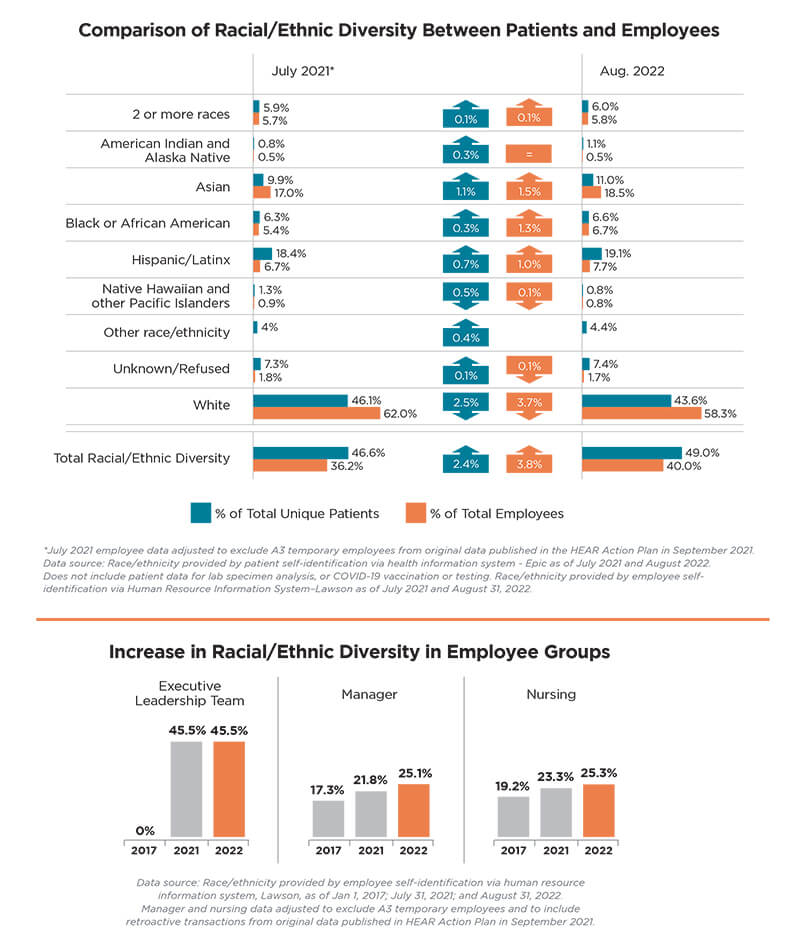
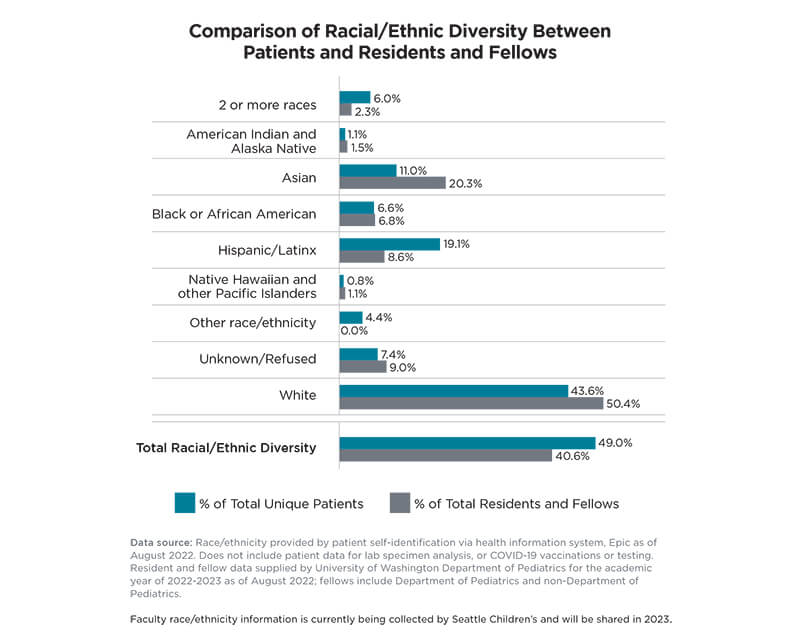
Progress Update
Below is an update on the progress made on actions that Seattle Children’s committed to in order to diversify the workforce and support racially and ethnically diverse workforce members.
Action
Create and implement a strategy for recruitment, development and retention of racially and ethnically underrepresented groups.
Progress to date
- Work continued to ensure candidate pools were diverse in order to increase hiring of diverse employees.
- Recruiting efforts target Historically Black Colleges and Universities (HBCU) as well as Tier 2 and Tier 3 (HBCU), Hispanic Student Institutions (HSI), Professional Diversity Network (PDN) and community partnerships.
- Leaders are now required to complete inclusive and equitable recruitment training.
- Employee referral program reinstated and boosted with support of Inclusion Networks (IN) by posting hot jobs and spotlighting employees.
- Finalized career video series highlighting a culture of inclusion, to be shared with current and future workforce members through SeattleChildrens.org and Seattle Children’s social media channels.
- A careers page and redesign of SeattleChildrens.org with an EDI focus expected to complete in Q4 of FY23.
- A cross-functional team from People and Culture, Legal and Regulatory reviewed inequities caused by inconsistent minimum education qualifications for skill-based job descriptions and updated background check requirements. Revised and standardized minimum education requirements to include “or equivalent experience” for more than 900 job descriptions to resolve challenges caused by background check regulations.
- Resourcing a Director of Retention and Engagement to focus efforts on retaining our workforce. Recruitment is underway.
“I came to Seattle Children’s as a diversity recruiter because I wanted to contribute to the changes being made to ensure better hiring improved retention rates. Diversity can’t be a superficial expression of support, but rather actionable steps that create an inclusive environment, representative of our patient population. From partnering with community organizations like CareerWork$ and Vocational Rehabilitation (DVR) so that more people of all abilities and backgrounds have a seat at the table, to advocating for more diverse representation in the images on our careers pages, I’m proud to lend my expertise and lived experiences to conversations and actions that helped reach our 40% diversity goal.”
— Jessica Buckner, Senior Healthcare Recruiter – Diversity Channels
Action
Partner with Inclusion Networks (IN) to create a candidate pipeline and enhance opportunities for racially and ethnically diverse workforce members.
Progress to date
- Introduced a formal evaluation for IN leaders in annual performance evaluations. The evaluation will recognize IN leaders’ leadership qualities, skills, and growth areas and identify improvement goals with their direct leader and Executive Leader IN champion for future opportunities in the organization.
Action
Develop and implement career pathways to support internal mobility that is intentionally inclusive of racially and ethnically diverse workforce members.
Progress to date
- Finalized six career pathways with 10 more underway. Work continues to improve application processes and outreach channels to more effectively reach underrepresented communities.
- Developing a career pathway includes:
- Reviewing team demographics, turnover and historical movement trends.
- Analyzing current state to identify barriers and staffing structure opportunities.
- Proposing an intuitive, realistic structure that offers room for growth within a role or department.
- Connecting teams and leaders with resources to support career development.
- An example of a finalized career pathway is the Grants and Contracts Administrator position in the Research
Center Business Office.
- Developing a career pathway includes:

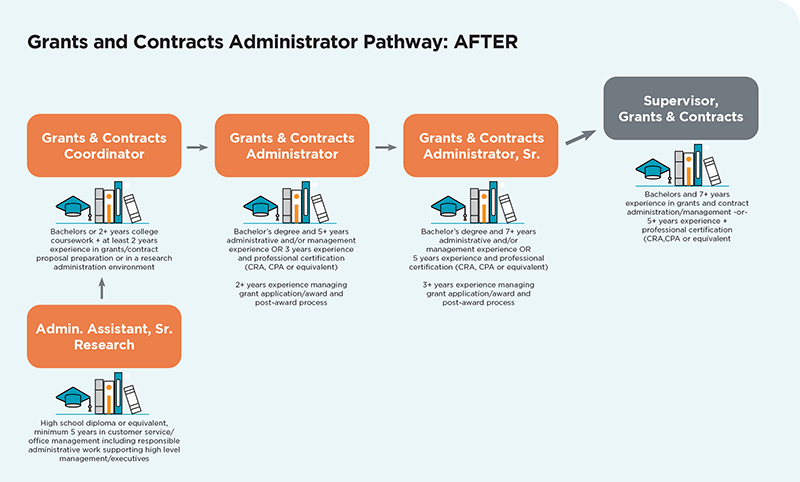
Research Center Business Office team building
The Research Center Business Office (CBO) developed a professional career pathway for Grants and Contracts Administrators. A cross-departmental project team developed new research administration roles including an entry-level grants and contract coordinator role and senior grant and contract administrator role, providing three levels in the CBO career ladder. Through this new model, several individuals hired as coordinators are training to become administrators and several administrators were promoted to senior administrators, helping to stabilize and grow the career pathway. With 50% of CBO leadership and staff currently identifying as racially diverse, investing in and retaining this talent pool will help provide more opportunities for a diverse and inclusive workforce.
The team also reflects geographic diversity as 16 Research Administration team members work remotely across Texas, Florida and Georgia. Seattle Children’s permanent out-of-state remote working strategy is designed to expand reach to diverse talent markets for hard-to-fill positions. Since launching in November 2020, Seattle Children’s now has 60 workforce members across the organization residing in Georgia, Florida, Texas and Montana — over 70% are from racially diverse backgrounds, reflecting their local communities and the Seattle Children’s patient population. Workforce members represent diversity of thought, background, geography, experience and perspective, making it important to create an inclusive environment and offer career pathways where team members, including those working remote, have career growth and advancement opportunities.
- Hosted first non-clinical summer internship program. Six students were selected from over 400 applicants, supporting six departments, with 83% identifying as a race or ethnicity other than White.
- Interns completed a 10-week program comprised of in-depth substantive learning and professional development activities conducted in partnership with the Seattle Children’s Research Institute Summer Scholars Program and Jim McDermott internship. The program prioritizes equity, diversity and inclusion and promotes greater alignment across Seattle Children’s internship experiences to support future talent pipelines.
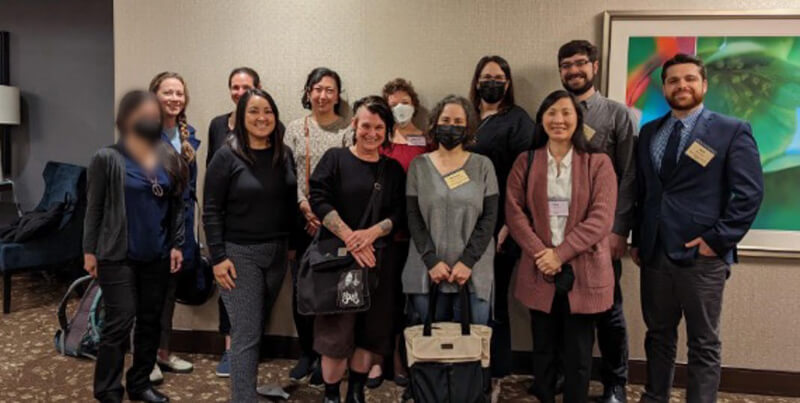
Professional development is key for developing stronger teams and providing opportunity for growth and career advancement. This summer, CBO workforce members attended National Council of University Research Administrators (NCURA) workshops, including Fundamentals of Research Administration and Sponsored Programs Administration II.
“This internship gave me great exposure and experience in the non-clinical and administrative aspect of healthcare that has strengthened my career aspirations in healthcare and continuous improvement.”
— Ashley Jung, Continuous Improvement Consulting Intern
Creating opportunities through Nurse Camp
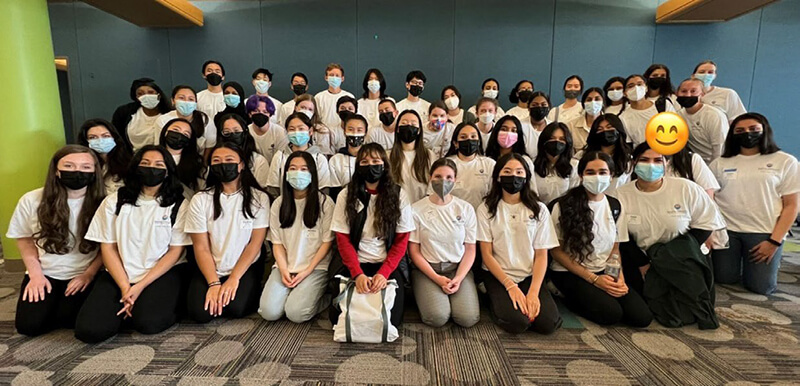
- Nurse Camp gives high school students exposure to pediatric healthcare through active participation in clinical observation sessions, nurse shadowing and career development workshops at Seattle Children’s over the course of five days. This program aligns with the organizational commitment to cultivate a diverse nursing workforce by building connections with local talent and facilitating learning opportunities with nursing professionals.
- This year’s Nurse Camp cohort was highly diverse, with 41 of 50 (82%) accepted campers identifying as a race or ethnicity other than White. To achieve a diverse applicant pool, outreach was conducted through various channels to increase visibility, working with high school partners and local community organizations including Rainier Scholars, WorkSource, and regional education networks.
- The intentionally inclusive application process:
- Actively requested students to identify 1) needed supports to ensure a successful experience (e.g., dietary, mobility support, needs for prayer, quiet space); 2) preferred pronouns; and 3) preferred language (speaking)
- Reviewed essays without identification, relying on multiple scores
- Created a mobile-friendly application to reduce technology and access barriers
Action
Strengthen, support and recognize workforce leadership and/or participation in Inclusion Networks.
Progress to date
- Made improvements to the articles of participation so Inclusion Network leaders operate with clarified expectations and strengthened structure to better the overall experience — all while continuing to compensate IN leaders.
Hola Inclusion Network
Bringing together Hispanic and Latinx workforce members and their allies to build a community within Seattle Children’s and the Pacific Northwest is the cornerstone of the Hola Inclusion Network. Connections and collaborations are integral for Hola. With a growing community of 250+, members consistently come together in community — from the Women’s Empowerment & Belonging series last March, to more informal weekly Cafecitos and the Hispanic Heritage Month Art Show highlighting members and their families.
“Not being from the Pacific Northwest and not having family around is not easy, but building a community was important to me. Hola has allowed me and many others to feel Seattle is home. We know there is a gap in Hispanic/Latinx workforce representation, but we also know a strong community is the cornerstone of retention and developing our community helps attracts new people. Which is why collaboration both internally with other Inclusion Networks and externally with other Hispanic/Latinx employee groups are always part of Hola.”
— Joe Arredondo, Chair of the Hola Inclusion Network
Action
Identify and eliminate disparities in experience and outcomes across terms of employment, specifically cultivation, hiring, onboarding, evaluation, advancement, corrective action, retention and separation.
Progress to date
- Continued the soft launch of the People and Culture and Leader Resource Center by adding services and tracking request and intervention trends that will inform the organization-wide October launch, ensuring that elevating the workforce experience is sustainable.
Action
Expand career pathways to attract and develop future diverse research trainees and staff and faculty members through Science, Technology, Engineering and Math (STEM) programs from elementary school to early career faculty positions.
Progress to date
K-12 STEM education and SCRI Summer Scholars Program (SSSP) for undergraduates
- 24 high school students completed the Research Training Program. In three weeks, students worked in a research laboratory environment and learned about topics including biochemistry, immunotherapy, gene editing and infectious diseases. Students also participated in workshops on college readiness and career exploration.
- 208 high school students participated in a one-week condensed online version of the Research Training Program.
- 50 undergraduate students from backgrounds underrepresented in science and medicine completed a 10-week internship, working with research teams on clinical or basic science research projects.
- Two awards totaling $4,163 were made to SSSP alumni to attend a conference to present on research projects conducted at Seattle Children’s Research Institute.
Diversity Supplement Connections
- Two matches were made between scholars and principal investigators with diversity supplement-eligible grants.
Health Equity Research Grants Program
- Awardees were selected for all three Center for Diversity and Health Equity funding opportunities for health equity research:
- Seed Grant — supporting early career faculty
- $50k awarded to Gina Sequeira, MD, MS, and Nicole Kahn, PhD: “Exploring health equity concerns in access to gender-affirming care for Black, Latinx, indigenous, and rural gender-diverse youth”
- Fellows and Residents’ Grant — supporting current fellows or residents during training
- $15k awarded to Tiffany Borbón, MD, PhD: “Utilizing artificial intelligence to improve language access for family-centered rounds”
- Mentored Scholars Grant — supporting early career faculty or postdoctoral fellows from historically underrepresented communities in science
- $139k awarded to Seja Abudiab, MD, MS, per year for two years: “Evaluating the impact of a community health worker intervention on infant and early childhood mental health in immigrant communities”
- Seed Grant — supporting early career faculty
Invent at Seattle Children’s Postdoctoral Scholars Program
Seattle Children’s Research Institute launched Invent at Seattle Children’s Postdoctoral Scholars Program, a $45 million investment in training early career scientists historically underrepresented in biotech in the development of therapeutics for childhood conditions. Seattle Children’s has pledged to raise an additional $10 million for the program.
